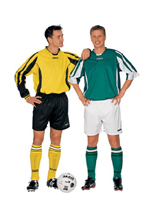Player's outfit
1. Field player's kit
As in other sports, the entire range of textile technology is being used for today's football wear. Functional clothing, iridescent fabrics and annually changing team strips are common. Since all these aspects apply to all sportswear, we will not go into them further here (Figure 1).
In this section we merely look at the shirt and shorts in their function as football clothing worn during play and not as advertising space or pieces of art. Shirt and shorts are used during the course of the game to distinguish the teams, but they are also, against the rules, misused to stop an opponent.
Inventors have developed two solutions to prevent that misuse: The first is to produce tightly-fitting clothing, worn close to the skin, to provide minimal opportunity for attacks by opponents, and fabrics that are extremely tear-resistant and durable to withstand any pulling and tugging. The second solution is to design football garments whose parts will be detached when the critical point is reached. The second development provides additional help to the referee in assessing the severity of the foul. However, such shirts or shorts are not tamper-proof.
In the late 1990s, patent applications boomed that were concerned with football wear with predetermined tear lines. This is probably the response of the spectators to the fact that the games become increasingly rougher and that the principles of fairness are being violated in the football leagues.
In a split of a second, a player can trick an opponent to gain a possibly match-winning advantage. This is why the visual design of the team uniform is also important. The design elements on the player's clothing are designed to enhance or reduce perception of the apparent movement of the player. In the extreme case, this produces a kind of "stealth effect", for example, with regard to a dribbling player. Thus the seemingly marginal aspect of the visual appearance of clothing has an influence on what happens on the pitch. Patent application US 2007/0 000 007 A1 reflects the actual technical designs of developers.
However, not every player of a team gets an opportunity in the starting lineup. The substitutes in northerly climes frequently have to wait a long time in inclement weather conditions before they can join the match.
If there is not enough time to warm up, the risk of injuries increases dramatically. DE 20 2008 003 043 U1 aims at reducing that risk by means of sweat pants with battery-powered resistance heating elements (3), which help to keep important muscles at operating temperature (Figure 2). Regrettably, this invention cannot be worn by underemployed goalkeepers because the necessary battery pouch (4) is relatively big. Although some would certainly welcome a similar product.
| Publication number | Year | Title | Brief description |
|---|---|---|---|
| DE 20 2008 003 043 U1 | 2008 | Trainingshose, insbesondere für Leistungssportler | Sweat pants with flat heating resistor elements to keep muscle groups warm, for example, of substitute players waiting. |
| US 2007/0 000 007 A1 | 2007 | Predictive and counter predictive visual stimuli | Design elements on clothing enhance or reduce accuracy of visual estimations of anticipated player movements. |


